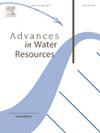Predicting water movement in unsaturated soil using physics-informed deep operator networks
IF 4
2区 环境科学与生态学
Q1 WATER RESOURCES
引用次数: 0
Abstract
Accurate modeling of soil water movement in the unsaturated zone is essential for effective soil and water resources management. Physics-informed neural networks (PINNs) offer promising potential for this purpose, but necessitate retraining upon changes in initial or boundary conditions, posing a challenge when adapting to variable natural conditions. To address this issue, inspired by the operator learning with more universal applicability than function learning, we develop a physics-informed deep operator network (PI-DeepONet), integrating physical principles and observed data, to simulate soil water movement under variable boundary conditions. In the numerical case, PI-DeepONet achieves the best performance among three modeling strategies when predicting soil moisture dynamics across different testing areas, especially for the extrapolation one. Guided by both data and physical mechanisms, PI-DeepONet demonstrates greater accuracy than HYDRUS in capturing spatio-temporal moisture variations in real-world scenario. Furthermore, PI-DeepONet successfully infers constitutive relationships and reconstructs missing boundary flux condition from limited data by incorporating known prior physical information, providing a unified solution for both forward and inverse problems. This study is the first to develop a PI-DeepONet specifically for modeling real-world soil water movement, highlighting its potential to improve predictive accuracy and reliability in vadose zone modeling by combining data-driven approaches with physical principles.
利用物理信息深层算子网络预测非饱和土壤中的水运动
非饱和带土壤水分运动的准确模拟对于有效的水土资源管理至关重要。基于物理信息的神经网络(pinn)为这一目的提供了很好的潜力,但需要在初始或边界条件发生变化时进行再训练,这在适应可变的自然条件时提出了挑战。为了解决这个问题,受比函数学习更普遍适用性的算子学习的启发,我们开发了一个物理信息深度算子网络(PI-DeepONet),整合物理原理和观测数据,模拟可变边界条件下的土壤水分运动。在数值模拟中,PI-DeepONet在预测不同测试区土壤水分动态时,尤其是外推时,在三种建模策略中表现最好。在数据和物理机制的双重指导下,PI-DeepONet在真实场景中捕获时空湿度变化的准确性优于HYDRUS。此外,PI-DeepONet成功地从有限的数据中推断出本构关系,并通过结合已知的先验物理信息重建缺失的边界通量条件,为正反问题提供了统一的解决方案。该研究首次开发了PI-DeepONet,专门用于模拟现实世界的土壤水分运动,通过将数据驱动方法与物理原理相结合,突出了其在提高渗透带建模预测准确性和可靠性方面的潜力。
本文章由计算机程序翻译,如有差异,请以英文原文为准。
求助全文
约1分钟内获得全文
求助全文
来源期刊

Advances in Water Resources
环境科学-水资源
CiteScore
9.40
自引率
6.40%
发文量
171
审稿时长
36 days
期刊介绍:
Advances in Water Resources provides a forum for the presentation of fundamental scientific advances in the understanding of water resources systems. The scope of Advances in Water Resources includes any combination of theoretical, computational, and experimental approaches used to advance fundamental understanding of surface or subsurface water resources systems or the interaction of these systems with the atmosphere, geosphere, biosphere, and human societies. Manuscripts involving case studies that do not attempt to reach broader conclusions, research on engineering design, applied hydraulics, or water quality and treatment, as well as applications of existing knowledge that do not advance fundamental understanding of hydrological processes, are not appropriate for Advances in Water Resources.
Examples of appropriate topical areas that will be considered include the following:
• Surface and subsurface hydrology
• Hydrometeorology
• Environmental fluid dynamics
• Ecohydrology and ecohydrodynamics
• Multiphase transport phenomena in porous media
• Fluid flow and species transport and reaction processes
 求助内容:
求助内容: 应助结果提醒方式:
应助结果提醒方式:


